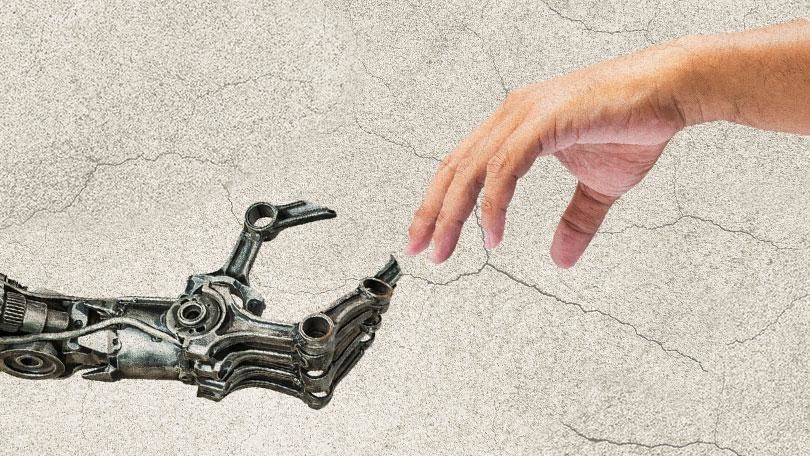
There is nothing more interesting and fascinating to me than those things I don’t quite understand.
Human vs artificial intelligence, the inner workings of matter in quantum mechanics, our ability to be sentient and develop knowledge, the rise of machines and its social implications, machines leapfrogging of human brain’s abilities and their possible take-over of the world by virtue of becoming conscious are a good deal fascinating topic.
I thus invested a fraction my quite limited free time to these challenging topics.
This article is meant to shed a bit of light into these rather obscure topics and the common thread I came to the conclusion they actually share.
For those who are field expert in any or multiple of the fields discussed, please forgive my dishonest attempt to shortcut the basics. The value of the article – if any – is to be found in spanning the different and only at first sight unrelated disciplines.
The quite interesting journey I mentioned in the opening has led me to consume many different texts, spanning from particle physics, quantum mechanics, ethics, philosophy and a few fundamental texts in artificial intelligence itself, after attending a few years ago an exotic class on “exponential technologies” in Silicon Valley, organised by smart people with a great sense of business.
An overall understanding of these very complex matter is still an ongoing endeavour, but I feel that I advanced enough in the process enough to try to draw some early insights.
Fascination number one: artificial intelligence.
This is a much-hyped topic, but on the other hand, if you lived in the eve of the 20th century and were not fascinated by machines or the onset of the industrial revolution, you would have missed out on one of history’s greatest of social transformations.
We are on verge of a new one and AI will be driving it.
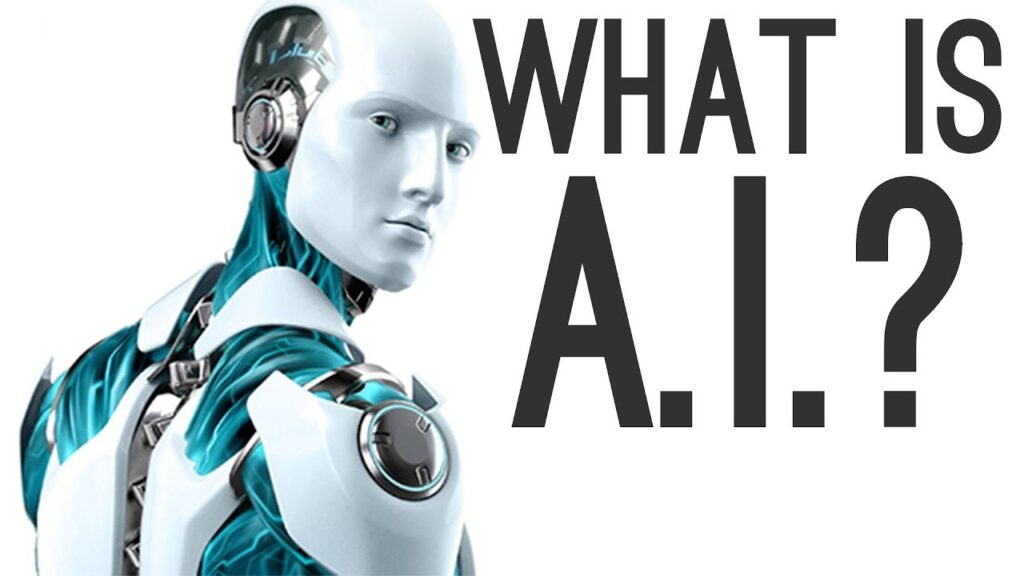
What exactly is Artificial Intelligence? It is – in the best definition I was able to find – the mimicking of sub functions of human intelligence by machines. This – human – ability to second its own brain has long improved in recent years, from the initial chess game against the machine to today’s quite satisfactory image and speech recognition algorithms.
We have managed to do just as well or better than human intelligence using machines in many different subfields, now the ultimate questions remains if we can breed machines with life, or at least one of its key components thereof: consciousness!
Consciousness is the key feature that parts animals from insentient matter and other unconscious beings (setting aside a possibility for consciousness and self-consciousness in trees and plants, Avatar style, very scientifically supported). When we observe other animals and recognise our own traits in them – the feeling of emotions, the application of complex reasoning, self-awareness, social behaviour – we feel closest to nature and somehow feel most sorry for having exploited it/them so blatantly.
This settles the argument whether AI is already here.
It is indeed.
And it is pretty much everywhere.
What about not just having machines reproduce distinct features of our intellect (context awareness, taking decisions, formulating strategies, planning etc) but duplicating the entire system, so that the Siris and Cortanas of the world become indistinguishable from our own true selves?
The most fascinating question is whether humans are ready to pass on their apex-species baton to machines, our non-genetic offspring.
Are we really close to the technological singularity, as is defined by Raymond Kurzweil’s and other leading futurologists as the point in time when machines will surpass human brain’s ability and power, not in terms of memory (which was a while ago) but in sheer computing power?
Yes! That is my suggestion and the leitmotiv of this article.
We can definitely expect machines to become sentient and self-conscious.
AI is the hidden and fascinating topic of a great 1970’s book, “Gödel, Escher Bach and the eternal golden braid” by one of the most Renaissance of modern day intellectuals and philosophers, Douglas Hofstadter, presently a professor of cognitive science at Indiana University.
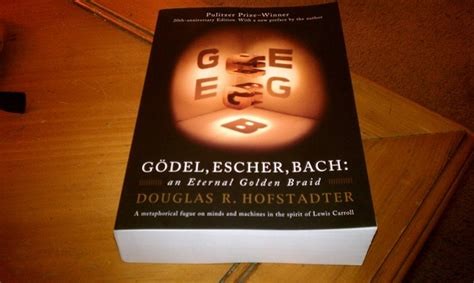
The latest edition of Prof. Hoefstader Opus Magnus.
Using a vast array of arguments, parallels, metaphors, multidisciplinary insights and solid backing into maths, logic and information technology, Prof. Hofstadter takes the reader into the realms of the human mind, the formation of thought and – ultimately – epistemology, the science what is ultimately knowable by the human intellect.
In this respect, it is foremostly a treatise on the merits and limits of human knowledge.
Gödel’s theorem plays a central role in the book, else the theorem that proves – using a rather convoluted argument and a smart way to self-reference itself – that not all true statements can be derived in axiomatic arithmetic formal systems, elsewise that some untrue statements can be derived, in an alternative formulation that adopts one of the findings of the theorem as extra axiom.
To rephrase this in simpler language, if we introduce the way to represent the succession of natural numbers and a set of elementary rules for the derivation of theorems (provable statements in the system), turns out that we can demonstrate that at least one true statement is not derivable from within the system, no matter how much constrained or expanded is the system and the set of rules that govern it.
The mathematical proof is too complex – and for most of you too tedious – to be captured here. But lets oversimplify it and say it has something to do with this prase, that has a decent amount of self reference in it:
This statement is false.
Nice right? is it true or false. True when proven false and false if proven true. And, by the way, it does self reference itself quite a bit, as it attempts to establish its on truism or falsehood.
So not all true statements are demonstrable in this formal system.
This proves to be the killer argument to the possibility to define a controlled environment within mathematics where everything can be implied or derived using simple logic in order to attain “truth”, and – by immediate extension – it apparently seals the coffin on human aspiration to absolute knowledge.
As arithmetics is the queen discipline of mathematics, and mathematics is the queen and purest of sciences, we are possibly dealing with a key crevice in the foundations of human knowledge.
Can we ever aspire to the truth, if we are so limited in the way we can represent it?
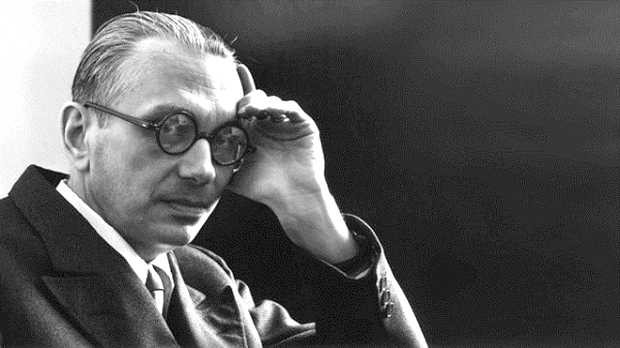
Mr Goedel – by his posture, he’s suggesting you don’t even try to look at his stuff 😉
What is knowledge and what is knowledgeable?
And, digging into the biological foundations of knowledge, where thought – the object of our intellect – becomes one with the inner workings of our mind that make it possible, how do our cognitive processes work?
What is conscience, our unique form of self-awareness, an intangible environment where we can develop thoughts while being conscious at the same time that we are doing exactly that, developing thoughts?
Alternatively, using a different formulation, once we know things and develop concepts, how do we use these concepts to understand ourselves?
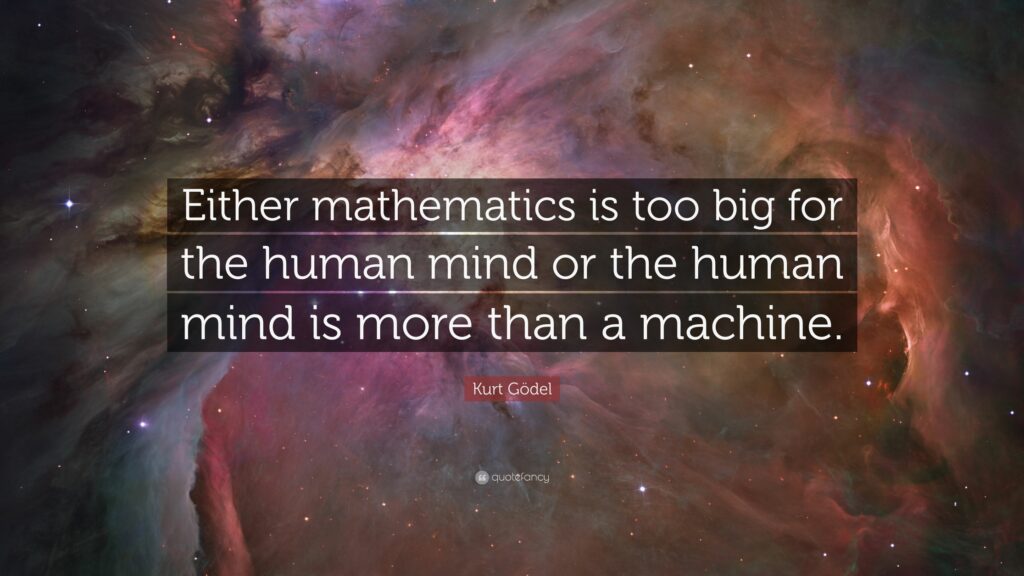
A nice quote from Mr. Goedel
Why is intimately related to machines and artificial intelligence?
In order to recognise our ability for self-reference in machines, we should first understand what is self-reference inside ourselves. Human ability to think rests on several concurrent levels of abstraction, sometimes more than quite a few.
As we give a speech we have prepared for at a conference, we most probably articulate language, look around, retrieve from memory the speech or at least its main structure.
But we will also verify in real time its impact on the audience, change the tone of voice, modify content, speak louder or softer, accommodate for questions and retarget content and attitude in delivering the speech all at the same time.
Human Intelligence is massively parallel, but it is also hierarchical at the same time.
We would never get lost – or at least should not – by looking at the red flower on the lady’s hat sitting in the front row. Our lead program, our “ontological being” is very well aware of the lead task he/she has committed to, in my example delivering the speech, so it would only consciously assign to this remark of our sensory system a brief span of attention, then quickly reverting to achieve the primary objective, delivering a good speech.
In this continuous shift up and down or back and forth between different levels of thinking – the game, the rules of the game, the rules of the rules of the game and so on – it’s where conscience arises, or at least so has it the argument of Prof. Hofstadter.
It is hard to imagine how consciousness come out to be from this jumping up and down in the system (push and pop, blue pill and red pill, yin and yang), when one is first exposed to this argument, but it eventually becomes more and more solid and friendlier by analogy when thinking how similar systems work.
Reasoning about the rules of a system requires you to get out of the system and getting into the meta-system, the system that deals with the system and so on. The higher the more abstract, the most implications for the lower levels.
When we play chess, to use another example, we think about the next moves, playing them in our head in advance, trying to anticipate the most probable combinations of moves by the opponent. These moves must obey chess rules, but must also shape our tactics – which moves yield a better outcome when checked against the disposition of nearby pieces – and also probably try to follow an overall game strategy, like “attack”, or “defence”, or “protect the Queen” or what else.
We continuously toggle between levels and each of these levels contributes to the next one: we possibly cannot move the pawn in B3, as it’s forbidden, but also need to move some other pawn forward if we want to let the bishop run free on the side.
There is also a detailed and organic level of intelligence, the neurons where we store information, but just like by reading the content of microchips we would not decode the program running in a computer and its intentions, we cannot understand a human being simply by doing CT scans of their heads something that seems very much in vogue these days. This is not to say it won’t yield some results, as the activation areas of the brain correlate well with certain defined human activity for sure. Very simply, it is not the way if we want to understand our mind. We are way off topic.
Reductionism is the scientific approach we used throughout history, starting from calculus where complex functions are broken and analysed at the infinitesimal level in order to draw conclusion for the the full solution. Similarly looking at the inner workings and into the details is the method we adopt to understand how the whole functions.
Unfortunately, this is a less useful approach when we try to understand human beings.
The human intellect is a massively parallel computing device.
The neurons interconnect in 3 and 4 dimensions, so we still haven’t devised a technology that is able even to fully mirror their functional disposition. Microchips in fact have long been interconnected in 2 dimensions, while 3 dimensions have just recently been experimented.
How is memory stored inside the brain?
Is it by analogy to how computers store information inside flash memories and hard disks? (reversing who’s copied whom 😀)
Science has not yet quite figured out even the basic processes occurring inside the brain. Scientist have assumptions, but nothing proved or provable.
The neuron is the basic cell underlying both transmission and storage processes.
But much like looking inside transistors won’t reveal much of the information that they are carrying, rather a set of zeros and ones, so looking at neurons at a microscopic scale does not tell much on how we achieve awareness.
So what? Desist?
Mankind has never stop researching, even when confronted with total failure and no insight.
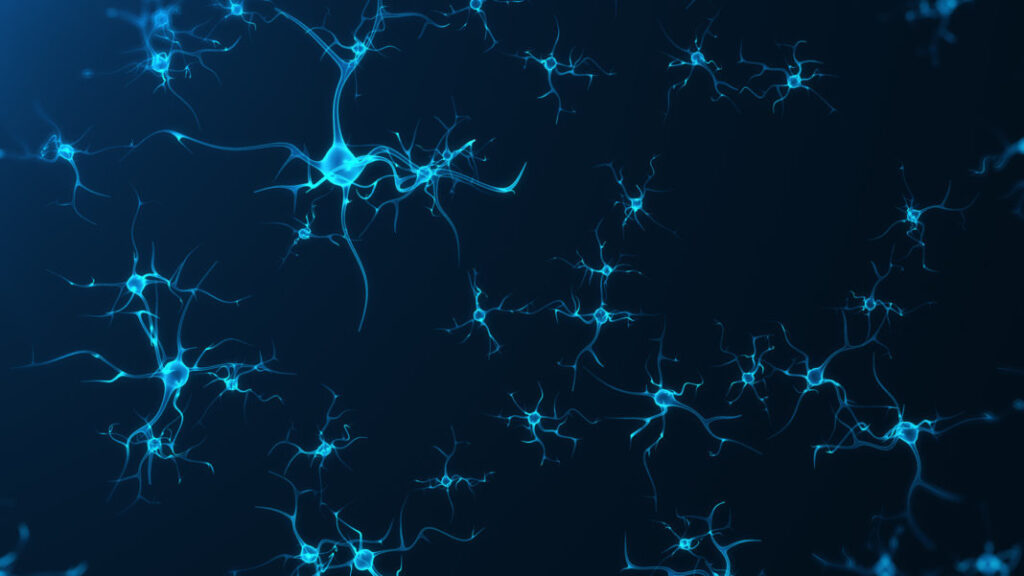
Fig 1 – Neurons
Now, is this is not complex enough for you, enter quantum mechanics.
Why QM?
QM has been the most important finding of the 20th century. Much more important than relativity, restricted or general, if I might.
Quantum Mechanics is so dearly complex, even at a basic stage that is used in the mnemonic of the first 24 digits of the PI:
How I want a drink, alcoholic of course, after the heavy lectures involving quantum mechanics. All of thy geometry, Herr Planck, is fairly hard else 3.14159265358979323846264
ok not much to do with machine awareness but I found this rather amazing, a complex matter used to shed mnemonic light on a more complex matter, an irrational number
Not being able to sum up even a basic grasp of the most interesting findings of Quantum Mechanics, I will point you to one of the sources out there to go through the topic, if you were not lucky enough to digest it as an undergraduate. But that would make a physicists of you, who make only 2% of the graduate base in the world.
Out of sheer curiosity I extended the graduate analysis to the worldwide population. Turns out that 0,2% of the world is a graduate. That is you count 1000 people and have two degrees. But if you run the numbers for physics, the numbers are much lower: 0,004% have a physics degree. This is how much Quantum Mechanics is an exoteric discipline: 4 people in 100.000 have degree in physics.
This is simply astounding.
Easier to say I am speaking to myself with this article 😅
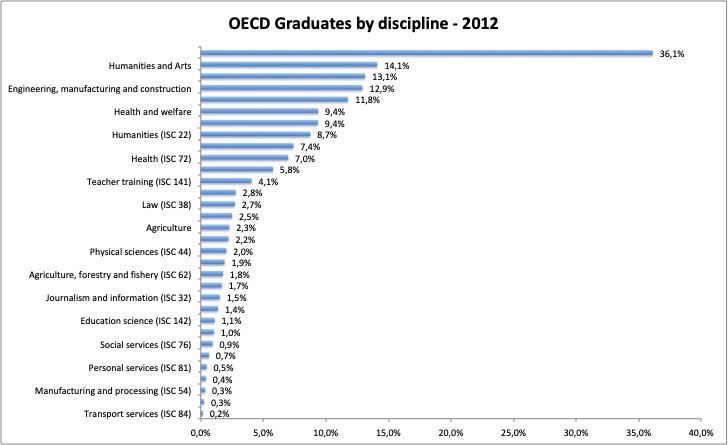
Fig. 2 – Oecd Graduates
Back to Goedel. This is where Goedel it becomes interesting and fruitful.
We discussed before the toggling back and forth between the different levels of reality.
We discussed the parallel computing of the mind, that is able to take care of several levels of control process, hierarchically organised, in a systematic way. We also hinted before at the chess game or speech analogy, where we need to toggle back and forth between the different levels, bring to the fore of the computing stack every time a different subsystem of the mind: motion control, speech control, visual control, memory recovery, memory recording etc
All of this happens quite naturally. We don’t have to think to make everything work nicely. We have been endowed with such an ability by eons of evolution: we would not be here otherwise. If we had not been able to coordinate very fast an instinctual reflex to back up from to a burning fire or the ability to coordinate eye – spotted! – and motor control – fucking run away! – at the sight of a dinosaur we would long be gone.

So where does awareness come into play?
And what exactly is awareness?
What does it mean to be alive?
Why are we different from animals?
Are we, by the way?
I will argue we are not. But that – lucky you – goes for another time.
Certain animals when confronted with a mirror after a while of practicing are able to recognise themselves.
Other try to mate or attack depending on the perception of the image in the mirror, even when they are smart animals (big cats for example) or otherwise have a hard time figuring out that the mirror is actually doing the same movements, just on the opposite side.
A few animals (chimps, elephant, dolphins, crows and – most incredibly – ants) eventually figure it out and start playing silly games with the newfound friend in the mirror, walking the fine line between recognising it as a copy of themselves and not recognising it.
Awareness is the ability to construct a story about yourself, to make sense of the massively parallel intellect we are endowed with and turn it into something sensible, linear, something we can deal with. We have a hard time memorising even slightly large numbers, so much so that credit cards and telephone numbers in certain countries for our convenience are grouped in four. Imagine dealing with parallel inputs. Well well, our abilities go well beyond our imagination if we manage to tap into our instinctual being, where the algorithms have been encoded by evolution and we manage to access sheer computing power, much like running in machine language gives an advantage over going through several level of higher order compiled languages.
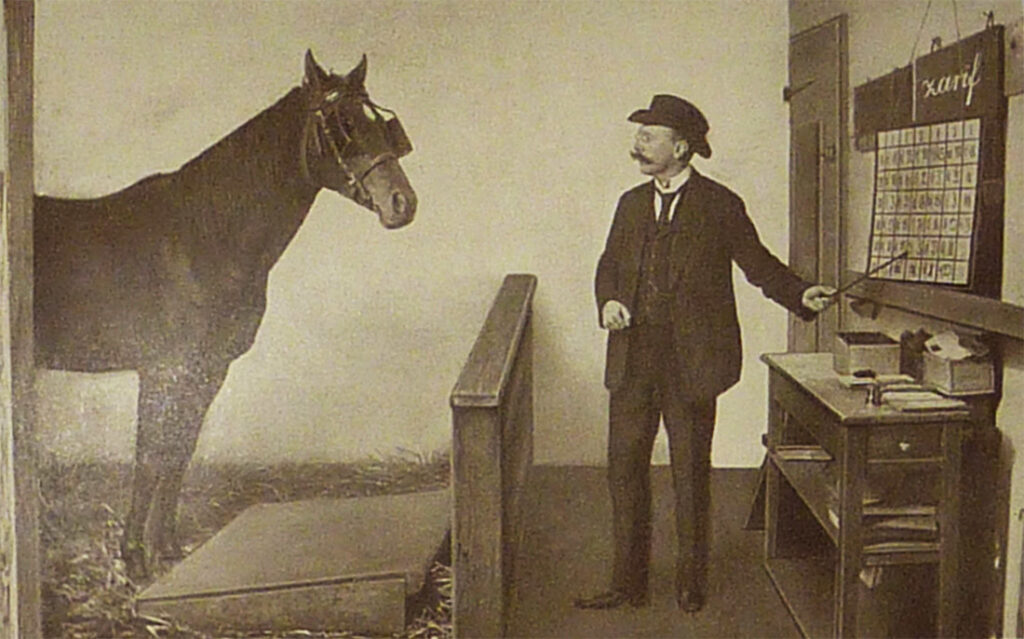
Clever Hans, the horse who could calculate, around 1890. Turned out to be a hoax.
An example are hyperthymestic or other highly mnemonic people, such as savants, mnemonist, eidetic memorists, mostly appearing to have foregone or limited some other form of intelligence in order to acquire their exceptional mnemonic abilities.
So what has quantum mechanics got to do with Artificial Intelligence?
Quantum Mechanics has a lot to do with our perception of the world and our ontology, to use a difficult word, the study of what is and what/who we are.
We will not delve into QM first and foremost because it is a fairly complex topic best left to the many excellent authors out there – my favourite being Mr. Feynman, whose third volume of his lectures in Physics is so clearly written to resemble almost pure art. On the other hand we are interested in the philosophical implications of QM, that are enormous.
Since Newton and Galileo physics, a new subject matter that departed from maths just around when they were alive, the world was a rather predictable and mechanistic place.
If I shoot a ball with a cannon, I can predict exactly where and when it will land. Similarly, if I sit under a tree I can expect an apple to fall on my head and not float in space, as I am not on board of the ISS*, the International Space Station.
**************************************************************************The reason why astronauts and apples float on board the ISS is not the one you think. It is not an effect of the diminishing strength of gravity with distance from the earth (F=k*m1*m2/r^2).
The distance factor accounts for only 10% of the difference, since the ISS orbits at a mere 400 km above the earth, as very clearly and cleverly explained by Samantha Cristoforetti.
If you want to the mats consider that 6300 earth radius + 400 = 6700 / 6300 = 1.05 ^ 2 = 1.1 = 10%

The reason why everything floats aboard the space station is that it is orbiting earth and – thus – is in a state of continuous free fall. Just like Einstein famous mind experiment of the free falling elevator, if you are inside an elevator falling to ground you don’t experience any force. This “happiest thought” of Einstein – as he dubbed himself his intuition – was experimentally confirmed using atomic clocks to the infinitesimal decimal place (2.2^10-7)
**************************************************************************
Now it gets fairly interesting.
Matter at the infinitesimal scale, as explained by at the beginning of the 1920s, follows an intrinsic probabilistic behaviour and can act as both particle and wave and show a lot of substantial additional weird properties, that seem at odds with the mostly predictable nature of things at the macro-scale.
Somewhere in between the micro and macro scale we need to come to terms that the unpredictability of the double slit experiment, whereby a particle goes through both slits at the same time and creates an interference in the projection panel becomes the very predictable world we are accustomed to at the macro scale.
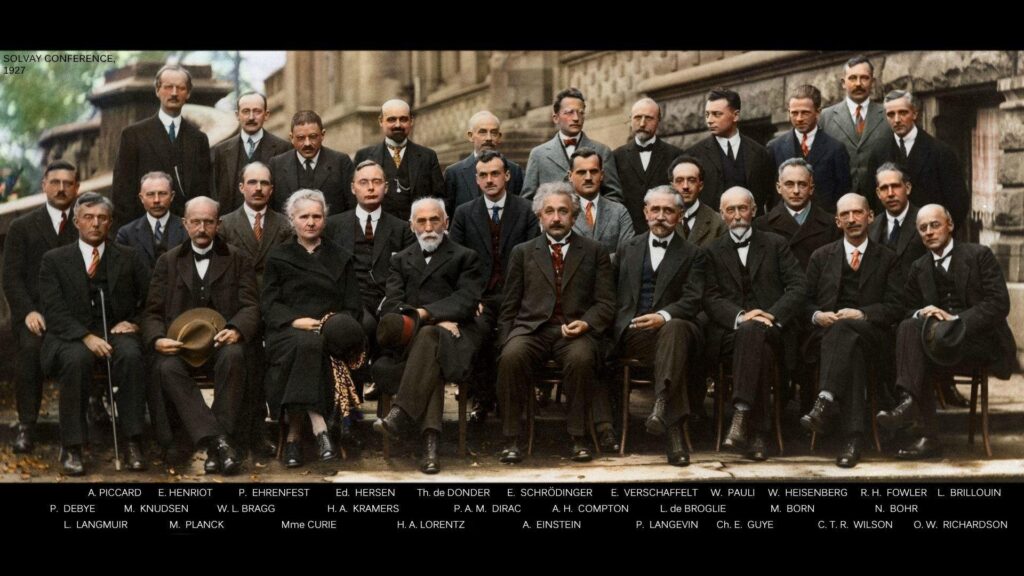
The V Solvay Conference of Physics Brussels. 17 of the 25 attendees went on to receive Nobel Prizes
We would never expect a planet to ponder whether to follow Saturn or Jupiter orbit.
We are used – and undoubtedly need – predictability.
This is not very dissimilar from what goes inside our minds.
Our brain is very much dissimilar from the idea we – mostly – have of it or build of ourselves.
We are so accustomed to personalisation (much like deity in the ancient and recent times) that we label our own true self the result of the brain processes that occur inside our brain: self-awareness.
But if you think about it for a minute, there is nothing really true about our very own “self”.
Our self, ego or whatever else you like to call is nothing more than a voice over on the very complicated plot that takes place inside our mind.
We are not one. Rather no-one or one hundred thousand, as Pirandello aptly quoted in his novel. He was talking about the epiphenomenon, how we appear to others, I am talking about the endophenomenon, how we construct an image of ourselves, but please grant me the poetic licence for this. We have to deal with the multitude of selves not just perceived by others but also originating from the many voices screaming for attention inside ourselves.
The image that suits of our ego is more like an orchestra director who has to deal with of the different instruments inside the brain: the perceptrons, the agents, the actuators to use technical language corresponding to the perceptions, the elementary functions of the brain – recognition, understanding, planning, executing – always running in parallel at the same time while being organised in a hierarchies of needs and actions, and often times conflicting and influencing one another.
The brain is massively parallel.
Potentially everything is wired or can be wired to everything else. And it is very flexible. The chemistry of the neurons, by stimulation and repetition enables what we call learning, that is wiring chemically a certain configuration and certain bond among the synapses.
Just like a single transistor is a very unstable component, but two transistor make a stable logical gate with predictable capabilities and eventually a flip flop to store information, so a neuron, when looked upon autonomously makes little sense. We understand its chemistry but we don’t understand the way it stores information and meaning. But this is not very different from what we see happening in the circuitry inside our pc. By looking at a set of stored zeroes and one we would be at odds at understanding what type of higher order meaning is stored inside the pc. And this meaning can reside at multiple levels. Much like Dante and several other leading literates and philosophers used to store up to 4 or more levels of meaning inside the same phrase – literal, allegorical, ethical and anagogical (= mystical or teleological else pertaining the religious or “higher” sphere), we routinely say one thing meaning another and we leave it to the person we are engaging in conversation with to interpret.
A neuron can have up to 7000 synapses, connection to other neurons. Can you imagine the amount of non linearity occurring there? We are at odds to come up with a reasonable and repetitive design involving the simple three terminal transistor, and here potentially we have a transistor with 7000 connection. It is estimated that inside the brain reside 100 bln neurons with (rounding up) 10.000 connections that makes it for 1000 trn synapses. We have absolutely no idea how this relates to computing power or memory storage, but it is suspected that the brain con hold anywhere between 1 tera and 1000 TB of information. The library of the Congress, by comparison, fits nicely in 10 TB.
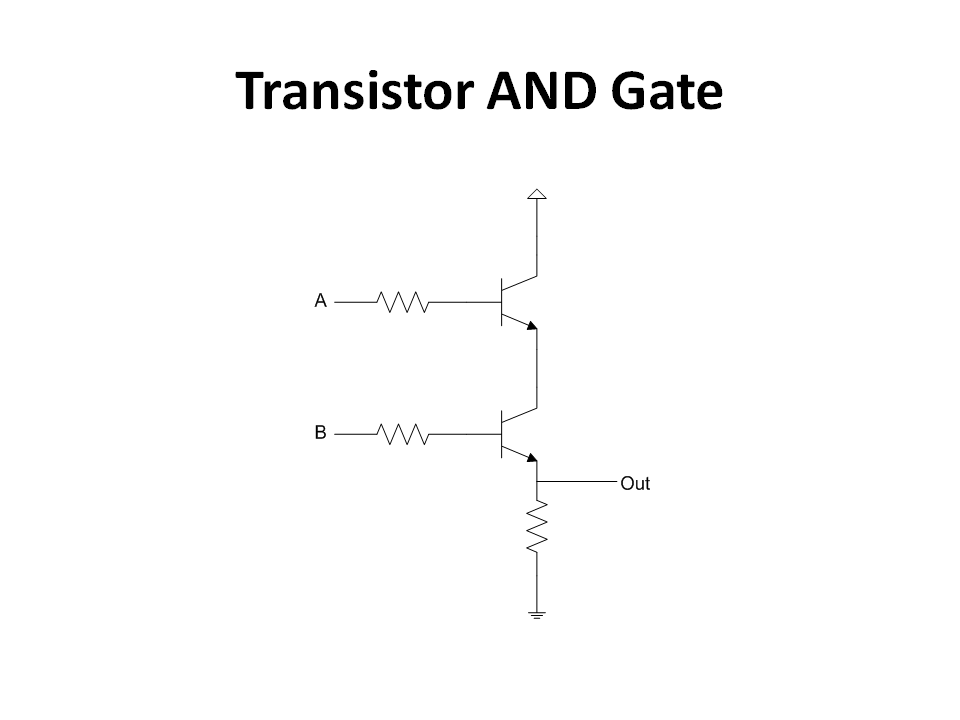
Logical AND Gate
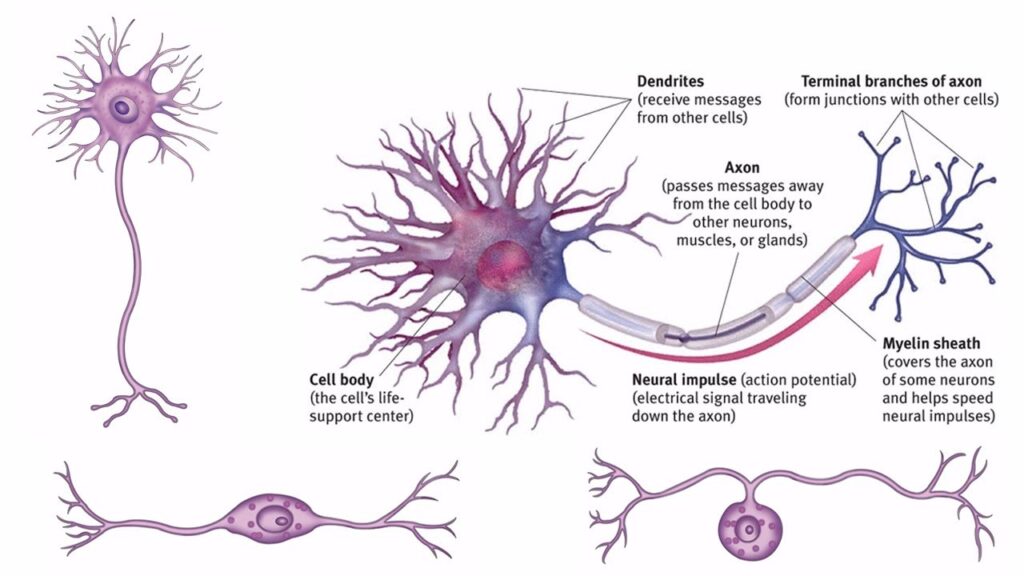
Neuron Dendrytes
We are basically letting a tripod compete with a millipedes. And that is unfair of us.
The amount of non linearity occurring in the circuitry of the brain with 7000 vs only 3 connections of the transistor is just too hard to imagine. It will thus be along time before we manage to fully understand how the brain codes information and a longer time yet before machines will be able to surpass human brain power.
